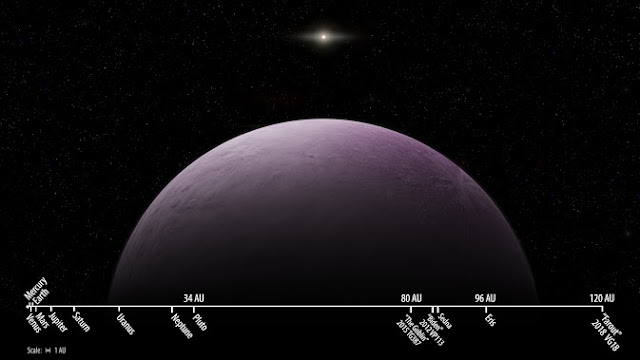Artist’s impression of a warped disk around a protostar. ALMA observed the protostar IRAS04368+2557 in the dark cloud L1527 and discovered that the protostar has a disk with two misaligned parts. Credit: RIKEN
Using the Atacama Large Millimeter/submillimeter Array (ALMA) in Chile, researchers have observed, for the first time, a warped disk around an infant protostar that formed just several tens of thousands of years ago. This implies that the misalignment of planetary orbits in many planetary systems, including our own, may be caused by distortions in the planet-forming disk early in their existence.
The planets in the Solar System orbit the Sun in planes that are at most about seven degrees offset from the equator of the Sun itself. It has been known for some time that many extrasolar systems have planets that are not lined up in a single plane or with the equator of the star. One explanation for this is that some of the planets might have been affected by collisions with other objects in the system or by stars passing by the system, ejecting them from the initial plane.
However, the possibility remained that the formation of planets out of the normal plane was actually caused by a warping of the star-forming cloud out of which the planets were born. Recently, images of protoplanetary disks, rotating disks where planets form around a star, have in fact showed such warping. But it was still unclear how early this happened.
In the latest findings, published in Nature, the group from the RIKEN Cluster for Pioneering Research (CPR) and Chiba University in Japan have discovered that L1527; an infant protostar still embedded within a cloud, has a disk that has two parts, an inner one rotating in one plane, and an outer one in a different plane. The disk is very young and still growing. L1527, which is about 450 light years away in the Taurus Molecular Cloud, is a good object for study as it has a disk that is nearly edge-on to our view.
According to Nami Sakai, who led the research group, “this observation shows that it is conceivable that the misalignment of planetary orbits can be caused by a warp structure formed in the earliest stages of planetary formation. We will have to investigate more systems to find out if this is a common phenomenon or not.”
The remaining question is what caused the warping of the disk. Sakai suggests two reasonable explanations. “One possibility,” she says, “is that irregularities in the flow of gas and dust in the protostellar cloud are still preserved and manifest themselves as the warped disk. A second possibility is that the magnetic field of the protostar is in a different plane from the rotational plane of the disk, and that the inner disk is being pulled into a different plane from the rest of the disk by the magnetic field.” She says they plan further work to determine which is responsible for the warping of the disk.
Additional Information
This research has been published in Nature (Advanced Online Publication) under the title “Warped disk around an infant protostar” by N. Sakai et al.
The Atacama Large Millimeter/submillimeter Array (ALMA), an international astronomy facility, is a partnership of the European Southern Observatory (ESO), the U.S. National Science Foundation (NSF) and the National Institutes of Natural Sciences (NINS) of Japan in cooperation with the Republic of Chile. ALMA is funded by ESO on behalf of its Member States, by NSF in cooperation with the National Research Council of Canada (NRC) and the Ministry of Science and Technology (MOST) in Taiwan and by NINS in cooperation with the Academia Sinica (AS) in Taiwan and the Korea Astronomy and Space Science Institute (KASI).
ALMA construction and operations are led by ESO on behalf of its Member States; by the National Radio Astronomy Observatory (NRAO), managed by Associated Universities, Inc. (AUI), on behalf of North America; and by the National Astronomical Observatory of Japan (NAOJ) on behalf of East Asia. The Joint ALMA Observatory (JAO) provides the unified leadership and management of the construction, commissioning and operation of ALMA.
RIKEN is Japan’s largest research institute for basic and applied research. Over 2500 papers by RIKEN researchers are published every year in leading scientific and technology journals covering a broad spectrum of disciplines including physics, chemistry, biology, engineering, and medical science. RIKEN’s research environment and strong emphasis on interdisciplinary collaboration and globalization has earned a worldwide reputation for scientific excellence.
Contacts
Jens Wilkinson
RIKEN Global Communications
Japan
Phone: +81-(0)48-462-1225
Email: pr@riken.jp
Nicolás Lira
Education and Public Outreach Coordinator
Joint ALMA Observatory, Santiago - Chile
Phone: +56 2 2467 6519
Cell phone: +56 9 9445 7726
Email: nicolas.lira@alma.cl
Masaaki Hiramatsu
Education and Public Outreach Officer, NAOJ Chile
Observatory , Tokyo - Japan
Phone: +81 422 34 3630
Email: hiramatsu.masaaki@nao.ac.jp
Calum Turner
ESO Assistant Public Information Officer
Garching bei München, Germany
Phone: +49 89 3200 6670
Email: calum.turner@eso.org
Charles E. Blue
Public Information Officer
National Radio Astronomy Observatory Charlottesville, Virginia - USA
Phone: +1 434 296 0314
Cell phone: +1 202 236 6324
Email: cblue@nrao.edu

























